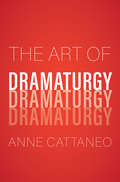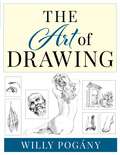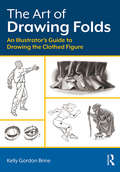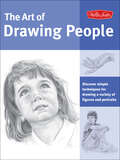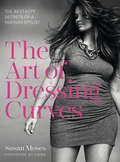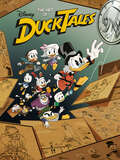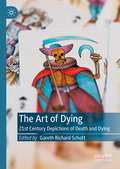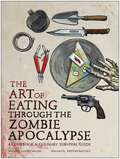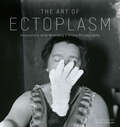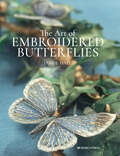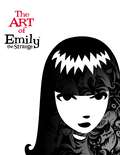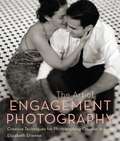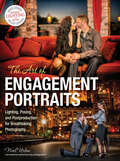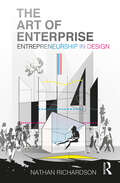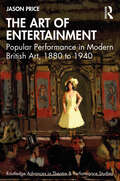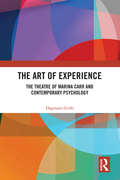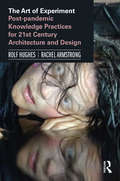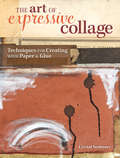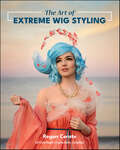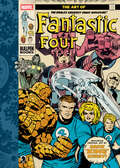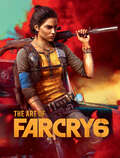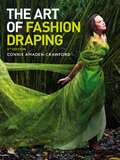- Table View
- List View
The Art of Dramaturgy
by Anne CattaneoAn introduction to the mysterious theater role of a dramaturg by a legend in the field Anne Cattaneo was among the first Americans to fill the role of dramaturg, one of theater&’s best kept secrets. A combination of theater artist, scholar, researcher, play advocate, editor, and writer&’s friend, it is the job of a dramaturg to &“reflect light back on the elements that are already in play,&” while bringing a work of theater to life. Cattaneo traces the field from its beginnings in the eighteenth century to the present and chronicles the multitude and variety of tasks a dramaturg undertakes before, during, and after a production is brought to the stage. Using detailed stories from her work with theater artists such as Tom Stoppard, Wendy Wasserstein, Robert Wilson, Shi-Zheng Chen, and Sarah Ruhl, as well as the discovery of a &‘lost&’ play by Langston Hughes and Zora Neale Hurston, Cattaneo provides an invaluable manual to those studying, working in, and interested in this most fascinating profession.
The Art of Drawing
by Willy PoganyOne of the most popular drawing guides ever published, The Art of Drawing has been an informative and thorough guide to several generations of aspiring artists. For fifty years, Willy Pogány has given the main principles of drawing in a simple, constructive way. By following the sequences laid out in the lessons, students quickly master the art of drawing. As further aid, Pogány gives a complete anatomical description of the body for each section, including a list of all bones and a description of the muscles and their uses. The Art of Drawing provides a complete drawing system and includes hundreds of illustrations. Every artist, beginning or advanced, should own this book.
The Art of Drawing Folds: An Illustrator’s Guide to Drawing the Clothed Figure
by Kelly BrineFrom Renaissance fresco painters to contemporary graphic novel artists, the ability to draw clothed figures from one’s imagination has always been crucial to artists – and exceptionally difficult to attain. With over 220 illustrations, The Art of Drawing Folds: An Illustrator’s Guide to Drawing the Clothed Figure reveals the logic and patterns in folds, enabling the reader to more easily predict the behavior of cloth when creating folds in their own drawings and paintings. Addressing folds in clothing systematically, the author provides a clear, concise approach to the analysis, classification and visualization of convincingly naturalistic folds. Starting with the nature of fabric and its geometry, this book methodically explores the reasons for fold behavior based on the construction of clothing and the shapes and actions of the human figure. An essential guide and reference for animators, illustrators, storyboard artists, comic-book artists, 3D modelers, sculptors, fashion designers and students, The Art of Drawing Folds simplifies one of the most complex and important aspects of drawing the clothed figure.
The Art of Drawing People: Discover Simple Techniques for Drawing a Variety of Figures and Portraits
by Walter Foster Creative TeamLearn to draw faces, features, and figures in graphite, with inspiration from four accomplished artists.Packed with practical advice, helpful tips, and fundamental techniques, this comprehensive book is an essential resource to which artists of all skill levels will refer again and again. The Art of Drawing People comprises instruction from a group of four experienced artists who demonstrate the processes of drawing the human head and clothed figure from infancy through old age in a variety of poses.The talented authors also share their knowledge about underlying anatomy, ethnic influences, and natural variations in shape, texture, and proportion, as well as basic information about drawing tools and pencil techniques.
The Art of Dressing Curves: The Best-Kept Secrets of a Fashion Stylist
by Susan MosesSusan Moses, the go-to celebrity stylist for curvy women both on and off the red carpet presents the first inspirational, confidence-building, prescriptive style guide for plus-size women who want to dress fashionably and look their beautiful best.Nearly two-thirds of American women are plus-size--and they care just as much about fashion and beauty as their thinner counterparts. They're tired of being ignored by the industry and shopping for styles wedged into the far reaches of department stores. Now, Susan Moses, a plus-size woman with a dynamic personality and an in-demand stylist whose clientele includes Hollywood and music industry celebrities, addresses this audience's needs with this essential handbook to help them look fabulous.The Art of Dressing Curves gives plus-size women the confidence and know-how to dress beautifully for their particular body shape. Gorgeously designed, filled with high-fashion photography, and written in Susan's down-to earth, accessible, and enthusiastic voice, The Art of Dressing Curves tells the story of her journey to self-acceptance and outlines her formula for seamless dressing that has helped some of the most iconic curvy women in music, film, and fashion look dazzling in the spotlight.From foundation garments to wardrobe essentials to hair and makeup, Susan dispenses advice on every aspect of dressing well for one's shape, size, and personality, insight supplemented by a wealth of elegant editorial photographs, anecdotes, tips, and sidebars, as well as lists of specialty retailers, designers, and websites that cater to plus-size.
The Art of DuckTales
by Disney Ken PlumeScrooge McDuck and nephews Huey, Dewey, and Louie are back in the 2017 remake of the classic series from Disney Television Animation, DuckTales! Now, find out about the making of DuckTales and read stories from the developers and cast covering every episode from all three seasons!Like Scrooge into the Money Bin, dive into this beautiful, oversized coffee-table book and read tales of the making of the series from developers Matt Youngberg, Francisco Angones, Suzanna Olson, and others. Join in on the adventure with exclusive interviews with the cast including David Tennant (Scrooge McDuck), Danny Pudi (Huey), Ben Schwartz (Dewey), Bobby Moynihan (Louie), Kate Miccuci (Webby), Don Cheadle (Donald Duck), and many more! Find out what it means to every day be out there making DuckTales! Woo-oo! Artwork and stories from every single episode! Exclusive interviews from the cast and crew. A behind-the-scenes look at the creation of the show. Never-before-seen artwork with captions by the creators.
The Art of Dying: 21st Century Depictions of Death and Dying
by Gareth Richard SchottThe Art of Dying: 21st Century Depictions of Death and Dying examines how contemporary media platforms are used to produce creative accounts, responses and reflections on the course of dying, death and grief. Outside the public performance of grief at funerals, grief can strike in anticipation of a loss, or it can endure, continuing to interject itself and interrupt a permanently changed life. This book examines the particular affordances possessed by various contemporary creative forms and platforms that capture and illuminate different aspects of the phenomenology of dying and grief. It explores the subversive and unguarded nature of stand-up comedy, the temporal and spatial inventiveness of graphic novels, the creative constructions of documentary filmmaking, the narrative voice of young adult literature, the realism of documentary theatre, alongside more ubiquitous media such as social media, television and games. This book is testament to the power of creative expression to elicit vicarious grief and sharpen our awareness of death.
The Art of Eating Through the Zombie Apocalypse: A Cookbook and Culinary Survival Guide
by Lauren WilsonJust because the undead's taste buds are atrophying doesn't mean yours have to! You duck into the safest-looking abandoned house you can find and hold your breath as you listen for the approaching zombie horde you've been running from all day. You hear a gurgling sound. Is it the undead? No—it's your stomach. When the zombie apocalypse tears down life and society as we know it, it will mean no more take out, no more brightly lit, immaculately organized aisles of food just waiting to be plucked effortlessly off the shelves. No more trips down to the local farmers' market. No more microwaved meals in front of the TV or intimate dinner parties. No, when the undead rise, eating will be hard, and doing it successfully will become an art. The Art of Eating through the Zombie Apocalypse is a cookbook and culinary field guide for the busy zpoc survivor. With more than 80 recipes (from Overnight of the Living Dead French Toast and It's Not Easy Growing Greens Salad to Down & Out Sauerkraut, Honey & Blackberry Mead, and Twinkie Trifle), scads of gastronomic survival tips, and dozens of diagrams and illustrations that help you scavenge, forage, and improvise your way to an artful post-apocalypse meal. The Art of Eating is the ideal handbook for efficient food sourcing and inventive meal preparation in the event of an undead uprising. Whether you decide to hole up in your own home or bug out into the wilderness, whether you prefer to scavenge the dregs of society or try your hand at apocalyptic agriculture, and regardless of your level of skill or preparation, The Art of Eating will help you navigate the wasteland and make the most of what you eat.
The Art of Ectoplasm: Encounters with Winnipeg's Ghost Photographs
by Serena Keshavjee EditorThe legacy of the Hamiltons’ psychic archive In the wake of the First World War and the 1918–19 pandemic, the world was left grappling with a profound sense of loss. It was against this backdrop that a Winnipeg couple, physician T.G. Hamilton and nurse Lillian Hamilton, began their research, documenting and photographing séances they held in their home laboratory. Their extensive study of the survival of human consciousness after death resulted in a stunning collection of hundreds of photographs, including images of tables flying through the air, mediums in trances, and, most curious of all, ectoplasm—a strange, white substance through which ghosts could apparently manifest. The Art of Ectoplasm invites readers to explore the Hamiltons’ research and photographic evidence which has attracted international attention from scholars and artists alike. Notable figures like Arthur Conan Doyle participated in the Hamilton family’s séances, and their investigations garnered support among the psychical scientific community, including renowned physicist Oliver Lodge, the inventor of wireless telegraphy. In the century since their creation, the Hamilton photographs (now housed at the University of Manitoba) have continued to perplex and inspire as the subject of academic study, comedic parody, and artistic and cinematic renderings. This fascinating collection reflects on the history and legacy of the startling and uncanny images found in the Hamilton Family archive. As contemporary society continues to feel the effects of the COVID-19 pandemic, The Art of Ectoplasm offers a compelling look at a chapter in social history not entirely unlike our own.
The Art of Embroidered Butterflies
by Jane E. HallWith gorgeous photos, a renowned textile artist guides you through the details of her creative process—and twelve amazing projects. The embroidery of Jane E. Hall is breathtaking, and in this book she combines her love of butterflies with her outstanding talent as a textile artist to produce three-dimensional renditions of exquisitely worked butterflies almost indistinguishable from the real thing.Using the finest of silk threads and needles, Jane lovingly creates her butterflies’ wings using the tiniest of stitches worked on to silk. They are then carefully cut away and the edges strengthened with hair-fine wire before being attached to the bodies, crafted from air-drying modelling medium and brushed with whisper-thin threads to resemble hairs. The butterflies are then placed within a setting of silk leaves and flowers, all made with the same painstaking attention to detail and expert skill as the butterflies themselves.This book provides a fascinating introduction to butterflies in nature, reflecting Jane’s love and admiration for these exquisite creatures, and goes on to describe the materials and methods Jane uses to produce her incredible creations. Twelve projects, each based on a different butterfly including the Painted Lady, Small Tortoiseshell, and Brimstone, present the finished piece along with the materials Jane used, and the photographs, swatches, drawings, and paintings that inspired it.
The Art of Embroidery Design: A Workshop for Developing Your Own Original Stitching
by Christi JohnsonFrom an acclaimed embroidery designer and bestselling author of Mystical Stitches, an accessible how-to guide full of original stitch designs that will inspire readers to pick up a needle and thread. Written for all levels of stitchers, The Art of Embroidery Design teaches the value of establishing a creative practice, with hands-on sketching and stitching exercises to help anyone build confidence in their design skills. Author Christi Johnson provides a workshop experience for readers looking to start from scratch. She breaks the design process down into approachable steps, including: -developing a vision -choosing a color palette -using variations in line weight to create dimensionality -achieving a range of textural effects. Dozens of colorful photos of the author's own work are accompanied by historical examples from artisans in Mexico, India, Peru, China, Nigeria, and more, as well as profiles of some of the most inventive contemporary embroidery artists–it's a complete workshop in a book.
The Art of Embroidery Design: A Workshop for Developing Your Own Original Stitching
by Christi JohnsonFrom an acclaimed embroidery designer and bestselling author of Mystical Stitches, an accessible how-to guide full of original stitch designs that will inspire readers to pick up a needle and thread. Written for all levels of stitchers, The Art of Embroidery Design teaches the value of establishing a creative practice, with hands-on sketching and stitching exercises to help anyone build confidence in their design skills. Author Christi Johnson provides a workshop experience for readers looking to start from scratch. She breaks the design process down into approachable steps, including: -developing a vision -choosing a color palette -using variations in line weight to create dimensionality -achieving a range of textural effects. Dozens of colorful photos of the author's own work are accompanied by historical examples from artisans in Mexico, India, Peru, China, Nigeria, and more, as well as profiles of some of the most inventive contemporary embroidery artists–it's a complete workshop in a book.
The Art of Emily the Strange
by Rob RegerIn her fifteen-plus years in existence, oddballs, outcasts, and art freaks the world over have grown to know and love a strange young girl named Emily. With roots in the punk-rock art scene of Santa Cruz skate culture and an early appeal to European trend spotters, the iconic image of Emily and her philosophy of devout individualism have become deeply rooted in global culture. The Art of Emily Volume One is the first-ever collection of images showing the wide and inspired range of artistic styles and mediums that have been used to create the world of Emily the Strange. From skateboard stickers to custom rock-and-roll album art, large-scale psychedelic paintings, and insanely intricate Mongolian paper cutting, the fantastic and artful imaginings of Rob Reger, Buzz Parker, and a staggeringly talented array of collaborators will give insight and inspiration to any Emily fan.
The Art of Engagement Photography: Creative Techniques for Couples in Love
by Elizabeth EtienneThis beautiful guide to engagement photography will show aspiring and professional wedding photographers how to boost their current income by offering higher-quality engagement sessions (or by adding them for the first time). Written by award-winning photographer Elizabeth Etienne, this modern guide to engagement photography offers portrait and wedding photographers a step-by-step approach to shooting in-demand engagement sessions and maximising an often-untapped revenue stream. Including 200 inspiring images and written in a fresh style, this guide offers a high-end, magazine-style approach that is coveted by brides and wedding photographers alike.
The Art of Engagement Portraits
by Neal UrbanWith bold colors, inventive lighting, creative postproduction, and eye-catching poses, Neal Urban creates engagement portraits that go far beyond the expected. In this book, he takes you behind the scenes with dozens of couples to show you how each image was conceptualized, customized, and brought to life. Under Neal’s careful eye, a patch of tall grass in a parking-lot becomes an exotic setting for two, the couple’s favorite dive-bar is transformed into a backdrop for timeless romance, and city streets become cinematic wonders. Shooting in the late-afternoon, sunset, and evening hours, Urban works carefully with the natural light, ambient sources in the scene, off-camera flash, LED, and tungsten sources to beautifully sculpt the couple and bring his scenes to life. Spend a few hours perusing this book and you’ll never approach engagement photography the same way again!
The Art of Engagement Portraits
by Neal UrbanWith bold colors, inventive lighting, creative postproduction, and eye-catching poses, Neal Urban creates engagement portraits that go far beyond the expected. In this book, he takes you behind the scenes with dozens of couples to show you how each image was conceptualized, customized, and brought to life. Under Neal's careful eye, a patch of tall grass in a parking-lot becomes an exotic setting for two, the couple's favorite dive-bar is transformed into a backdrop for timeless romance, and city streets become cinematic wonders. Shooting in the late-afternoon, sunset, and evening hours, Urban works carefully with the natural light, ambient sources in the scene, off-camera flash, LED, and tungsten sources to beautifully sculpt the couple and bring his scenes to life. Spend a few hours perusing this book and you'll never approach engagement photography the same way again!
The Art of Enterprise: Entrepreneurship in Design
by Nathan RichardsonThe Art of Enterprise: Entrepreneurship in Design explores the form and nature of entrepreneurship in a range of creative disciplines. It explores the complex ecology of activities that enable design, entrepreneurship, and alternative methods of practice within a creative practice, and for the benefit and engagement of society. The book is structured in four thematic sections: the Alpha Room, Beta Portal, Gamma Field, and Delta State. Within each section, the chapters address such topics as experience, mindset, activity, collaboration, and value. In that sense, The Art of Enterprise is composed of the way in which one experiences, thinks about, works, collaborates, and creates value in the mind, studio, prototype, and marketplace. It includes a curated selection of contemporary practices engaged in entrepreneurship around the world and interviews from leading entrepreneurs and design professionals capturing advice and inspiration. With an open-ended set of activities, charts, worksheets, and discussion questions, The Art of Enterprise fosters entrepreneurial thinking in formative projects and practices for students, academics, and professionals.
The Art of Entertainment: Popular Performance in Modern British Art, 1880 to 1940 (ISSN)
by Jason PriceIn this book, theatre historian Jason Price looks at the relationships and exchanges that took place between high and low cultural forms in Britain from 1880 to 1940, focusing on the ways in which figures from popular entertainments, such as music hall serio-comics, clowns, and circus acrobats, came to feature in modern works of art.Readers with an interest in art, theatre, and the history of modern Britain will find Price’s approach, which sees major works of art used to illuminate the histories of once-famous entertainers and the wider social, political, and cultural landscape of this period, accessible and engaging. The book will bring to life for readers some of the most vivid works of modern British art and reveal how individuals historically overlooked due to their gender, sexuality, or race played a significant role in the shaping of British culture during this period of monumental social change.
The Art of Experience: The Theatre of Marina Carr and Contemporary Psychology
by Dagmara GizłoThe Art of Experience provides an interdisciplinary analysis of selected plays from Ireland’s premier female playwright, Marina Carr. Dagmara Gizło explores the transformative impact of a theatrical experience in which interdisciplinary boundaries must be crossed. This book demonstrates that theatre is therapeutic and therapy is theatrical. The role of emotions, cognitions, and empathy in the theatrical experience is investigated throughout. Dagmara Gizło utilises the methodological tools stemming from modern empirically grounded psychology (such as cognitive-behavioural therapy or CBT) to the study of theatre’s transformative potential. This book will be of great interest to students and scholars of theatre, performance, and literature, and will be a fascinating read for those at the intersection of cognitive studies and the humanities.
The Art of Experiment: Post-pandemic Knowledge Practices for 21st Century Architecture and Design
by Rachel Armstrong Rolf HughesA handbook for navigating our troubled and precarious times intended to help readers imagine and make their world anew. In search of new knowledge practices that can help us make the world livable again, this book takes the reader on a journey across time—from the deep past to the unfolding future. The authors search beyond human knowledge to establish negotiated partnerships with forms of knowledge within the planet itself, examining how we have manipulated these historically through an anthropocentric focus. The book explores the many different kinds of knowledge, and the diversity of instruments needed to invoke and actuate the potency of human and nonhuman agencies. Four key phases in our ways of knowing are identified: material, strengthening, reconfiguring and extending, which are exemplified through case studies that take the form of worlding experiments. This pioneering work will inspire architects, artists and designers as well as students, teachers and researchers across arts and design disciplines.
The Art of Expressive Collage: Techniques for Creating with Paper and Glue
by Crystal NeubauerWhat story will your art express?There's a dialogue waiting to happen on your worktable. The Art of Expressive Collage will teach you to listen to what paper and glue, ink and paint have to tell you. From the fear of messing up to the excitement of letting things flow, you'll come to see the common thread in the bits and pieces you collect. You'll discover new ways to think about arranging these bits in your work as you express yourself with lines, smudges and translucent layers.Beyond using paper and glue you'll discover:The best places to hunt for and gather ephemeraHow to prepare various papers for collage using staining and embellishing techniquesAn understanding of the elements of design and compositionTips for making unique marks, adding photos, creating textures and much more Begin a new chapter with your art; see how the techniques inside The Art of Expressive Collage can help you express a brand new voice!
The Art of Extreme Wig Styling
by Regan CeratoA styling handbook for the ambitious wigsmith! Complement your cosplay with incredible wigs—custom-designed and created by you! Regan Cerato of Cowbutt Crunchies shows you how to make dozens of extravagant wigs for cosplayer needs, from dyed spikes to dragon scales to fiber flowers and so much more! Extravagant wigs can be intimidating, they can even stump the most seasoned of crafters but with the expert Cosplay guidance wig making can be accomplished by everybody. Whether you’re a new or experienced sewist, this handbook will help you turn your cosplay dreams into reality. All the core basics that will help take your wigs to the next level Learn trimming tips, dyeing techniques, weft basics, teasing, volumizing, and so much more With the right tips and tricks, an arsenal of skills, and guidance from seasoned cosplayers—extreme wig making can be for everybody!
The Art of Fantastic Four
by Stan LeeThis oversized, 10" x 14" hardcover edition is a stunning collection of iconic covers and original art from Jack Kirby&’s groundbreaking comics run on The Fantastic Four. It features full stories from five issues, reproduced from Marvel&’s archival scans, alongside essays and commentary by editor-designers Ian Chalgren and John Lind.Since its debut in 1961, The Fantastic Four has been a cornerstone of the Marvel Age of Comics. The series, co-created by legendary artist Jack &“King&” Kirby and writer Stan Lee, revolutionized the comic book industry and set the standard for a new brand of super-hero storytelling. Kirby, one of the most influential creators in comic book history, infused the series with his dynamic artwork and unparalleled imagination, cementing its place in comics history.This oversized Bullpen Books edition focuses on Kirby&’s lengthy run on The Fantastic Four from 1961 to 1971. It includes complete stories from issues #60, #71, #82, and #83, and the spectacular 48-page Fantastic Four Annual #6. These selections provide a glimpse into the early days of Marvel&’s bullpen, showcasing Kirby&’s artistic genius during one of his most creative periods.Dark Horse&’s Bullpen Books series of art books pays tribute to the characters and creators of Marvel Comics. This second volume honors Jack Kirby&’s work on The Fantastic Four and follows up on the Bullpen Books series&’ inaugural installment—The Art of the Amazing Spider-Man.
The Art of Far Cry 6
by UbisoftExplore the vibrant island of Yara, a nation trapped in time. Dark Horse Books and Ubisoft have joined forces to create The Art of Far Cry 6, a beautiful volume that is perfect for any fan of the Far Cry adventures. Welcome to Yara. Viva Libertad!
The Art of Fashion Draping
by Connie Amaden-Crawford“This is the most comprehensive teaching tool for learning and mastering draping techniques. The illustrations and the text for each drape are clear and explicit.” Laura K. Kidd, Southern Illinois University, USA <p><p> Learn to drape fabric on a dress form to create your own patterns. <p><p> The step-by-step instructions are organized from basic to advanced projects using both imperial and metric measurements, so you don't have to convert measurements. The book includes a wide variety of fashion styles, from bodices to bias-cut gowns. Intermediate and advanced design variations include an off-shoulder sleeve design and a peplum design. More than 1,000 two-color line drawings show you each draping step. <p> - Checklists to evaluate and analyze designs <p>- Cross-referencing of techniques across chapters <p>- Online STUDIO includes video tutorials explaining key draping skills and techniques <p>- Lay-flat binding makes the book easy to use while draping garments
